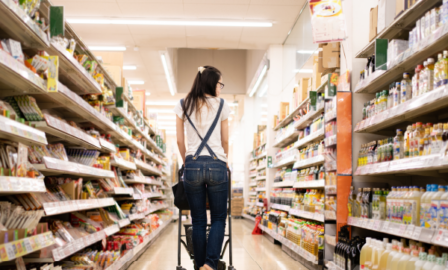Protecting Essential Items: Coronavirus Impact on Grocery
Essential items are quickly becoming the sole reason why the general population is permitted to leave their homes. As the coronavirus pandemic further digs its claws into the fabric of society, it is clear that its impacts will be long-lasting. Few industries seem to be immune to the pandemic’s economic toll with the exception of one—grocery. Deemed as essential items by virtually all modern societies, retailers of food and staple products are seeing unprecedented consumer demand. The coronavirus impact on grocery is driving rapid change, and grocers today are quickly taking stock of their capabilities to serve consumers in unexpected ways.
The grocery industry is seeing extraordinary foot traffic lately. Warehouse stores like Costco and Sam’s Club are seeing 39% increases in traffic, with markets such as NYC spiking at 51%. Nationally, visits to local grocery stores are up 19%. Given the criticality of maintaining continuity of services, some local governments are going as far as to deem grocery workers as emergency personnel. With checkout lanes full and inventory quickly turning, some may question why grocers should be concerned about the future. The answer lies within the abruptly shifting expectations of shoppers today—shoppers that now need to place a premium on personal health and safety.
With governments worldwide imposing guidance to limit public gatherings, it’s proving difficult to implement that guidance at the local supermarket. Consumers urgently need products as they prepare to shelter in place. However, as logic would suggest (and studies are confirming) the large supermarkets can unfortunately serve as vectors for the coronavirus. Shopping carts at a typical local food store can carry hundreds of times more colony-forming units of bacteria per square inch than surfaces in your bathroom—including your toilet handle. Most shoppers are heeding guidance to frequently wash their hands, but it’s important for grocers to clearly demonstrate a commitment to public health as well. These tactics might include closing stores for deep sanitation, marking 6-foot separation within checkout lanes, capping store occupancy, or installing plexiglass “sneeze guards” for cashiers. For those shoppers that choose to brave the aisles of their local supermarket, these public safeguards go a long way. But what about those shoppers looking for a bit more “social distance”?
The shopping behaviors of consumers are drastically shifting in light of the pandemic. The dollar value of buy online pickup in-store and delivery orders from full-assortment grocery merchants is up over 200%. Of those placing online food orders, 41% were doing so for the first time. Shoppers are beginning to treat their vehicles as safe havens, patronizing only those merchants that provide curb-side pick-up (or better yet, home delivery). While grocers’ balance sheets in some ways are reaping the benefits of panic-buying, the industry isn’t immune from shifting consumer expectations for expanded home delivery and click-and-collect options. Kroger, an industry leader in click-and-collect with their ClickList offering, has gone as far as piloting click-and-collect only stores. This type of proactive response will position them well should the coronavirus impact on grocery worsen. As demands for their products mount, Kroger is also working creatively to flex up their resources by borrowing from other impacted service industries like hospitality and foodservice. Other retailers like Walgreens are leveraging existing assets like pharmacy drive-thrus to support grocery sales. At the end of the day, consumers are simply asking themselves 4 questions: Is the product in stock? Where is it available? What is the most convenient location? How fast can I get it? It’s likely we’ll see fit-for-purpose digital solutions, like OurStreets, creatively address the increasing need among consumers to understand real-time product availability before leaving the house.
For years, the grocery industry in general has been able to get away with deferring digital investments. However, with product availability across many essential items categories now compromised, the urgency is growing for these retailers to double-down on digital solutions that create transparency into available inventory. Even for those grocers with mature ecommerce offerings, the surge in demand has proven trying—even Amazon has had to temporarily close Prime Pantry as a result of unsustainable order volumes. Independent grocery delivery services like Instacart, despite navigating a labor strike over employee safety measures, are poised to hire thousands of additional personal shoppers to cover the influx of new orders through their app.
With consumers abandoning traditional ecommerce options due to long wait-times and technical difficulties, click-and-collect could very well become the future of grocery shopping, not only now with essential items, but in the future. Grocers large and small should maintain a focus keeping shelves stocked, keeping their employees safe, and demonstrating a commitment to public health throughout all operations of their stores. However, the lessons of this pandemic should not be soon forgotten. Because of the coronavirus impact on grocery, shoppers have been introduced to digital capabilities they might not have otherwise tried. They continue to grow more comfortable with these new options. Investments now in digital capabilities will offer returns well into a post-coronavirus future.



